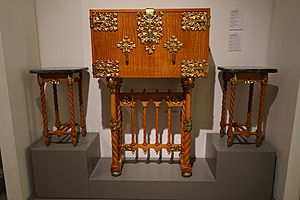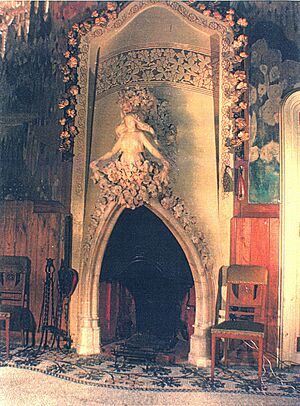Casa Trinxet facts for kids
The Casa Trinxet was a beautiful building in Barcelona, Spain. It was designed by a famous Catalan architect named Josep Puig i Cadafalch. He also designed the Casa Amatller. The Casa Trinxet was built between 1902 and 1904.
It was located in the Eixample area of Barcelona. Many people called Casa Trinxet "one of the jewels of Barcelona Modernisme." It was even part of Barcelona's famous Illa de la Discòrdia, or "Block of Discord." This block got its name because three great architects – Domènech i Montaner, Puig i Cadafalch, and Antoni Gaudí – all had buildings there. Their different styles created a fun "discord" or contrast.
Avelino Trinxet Casas, who came from a family in the textile business, asked for the house to be built.
Contents
Art Inside Casa Trinxet

A talented artist named Joaquin Mir Trinxet (who lived from 1873 to 1940) painted many murals inside the house. He started this work in 1903. These paintings were a very important part of his art career.
Mir Trinxet's paintings in the house were unique. He used a style that made the colors seem to blur together. It was like a haze of tiny dots that created a magical glow. For example, flowers in his murals looked like glowing orange and yellow lamps. They were set on a bed of lush green. The paintings made you feel like you were in a warm, fresh garden. This special technique made the murals seem to light up the rooms.
What is Catalan Modernism?

Modernisme was a special art movement in Catalonia, Spain. It was active from about 1888 to 1911. You might know similar styles like Art Nouveau or Jugendstil from other countries.
This movement was mostly focused in Barcelona. It is most famous for its amazing buildings. Architects like Antoni Gaudí, Lluís Domènech i Montaner, and Josep Puig i Cadafalch created many masterpieces. But Modernisme also included sculpture, poetry, theater, and painting.
Modernisme architecture often used curved lines instead of straight ones. It had lots of rich decorations and details. You would see many plant shapes and other natural designs. Buildings often looked uneven, which added to their unique beauty.
Many Spanish painters were part of this modern art movement. Artists like Santiago Rusiñol, Casas, and Joaquin Mir Trinxet helped shape Spanish painting in the early 1900s.
By 1910, Modernisme became very popular. Rich families loved to have buildings designed in this style.
History of Casa Trinxet
During the Modernisme period, wealthy families in Catalonia often built grand houses. These houses were usually named after their owners. The Casa Trinxet was built for the Trinxet family.
The Casa Trinxet was a stunning example of Modernisme. It had an amazing interior with beautiful decorations. For example, its stained-glass windows looked like paintings. These windows were made by a company called Rigalt, Granell y Cía. They followed instructions from the artist Joaquín Mir Trinxet.
Sadly, the Casa Trinxet was torn down in 1968. Many artists and thinkers tried to save it. They wanted it to become a museum of Modernisme art. But their efforts were too late.
Interesting Facts
- The Casa Trinxet won an award! Between 1899 and 1906, the Arts Building Annual Award honored many Modernisme buildings. These included the Casa Calvet, the Casa Lleó Morera, and the Casa Trinxet.
- Joaquim Mir, the artist who painted inside the house, once said: "All I want is for my works to lighten the heart and flood the eyes and the soul with light." He was a very famous artist in Catalonia.
Casa Trinxet in Books
The Casa Trinxet has been mentioned in many books. Some of these include:
- Torres García: Pasión Clásica
- Barcelona modernista
- El pintor Joaquín Mir, by Josep Pla
Other Famous Buildings Like Casa Trinxet
Before Casa Trinxet, other important buildings were designed by Josep Puig i Cadafalch. These include the Casa Amatller and the Casa Macaya. The Casa Amatller was transformed by Puig i Cadafalch in 1898. He gave it the look of an old Gothic palace, which was a style he used in other projects too.
See also
 In Spanish: Casa Trinxet para niños
In Spanish: Casa Trinxet para niños
- Illa de la Discòrdia
- List of Modernista buildings in Barcelona
Images for kids












